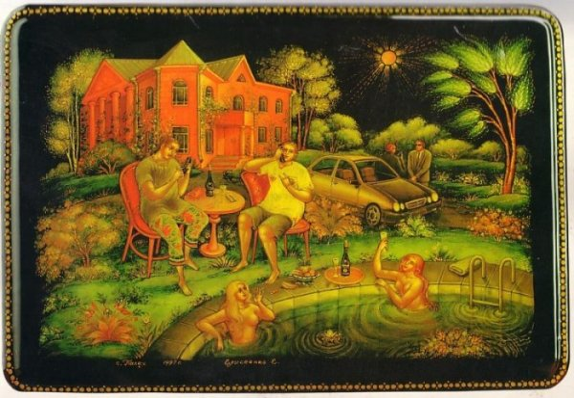Filed Under: Material culture > Arts or design > The World of New Russians store, Palekh-style tray
The World of New Russians store, Palekh-style tray

The ironic business art venture by Grigory Bal’tser, a prolific art dealer and collector, was launched in 1998, with a storefront on the prestigious Arbat boulevard in Moscow. Its first offerings included a book series by artist Katya Metelitsa and a variety of handcrafted objects in Russian folk-art styles. Every item sold at the World of New Russians mocked and mythologized so-called “New Russians”: the class of professional criminals and carpetbaggers whose wealth, violence, and excess dominated the public imagination during the 1990s.
The ironic works sold in the store depict New Russians in genre scenes emphasizing their ridiculous luxury, wild fashion, and overall habitus through a revitalizing appropriation of folk art forms like Palekh, Gzhel’, and Khokhloma. The folk art treatment turns the highly contemporary subject into an object of ridicule and lore—for example, this Palekh-style image replaces its usual fairy-tale motifs with the fairy tale of the New Russian’s decadent lifestyle.
Meanwhile, Metelitsa approached the New Russian as a subject of both playful prodding and investigation through books like The New Russian Alphabet (recipient of the 1998 Golden Ostap Prize for Best New Publication); the New Russian Cookbook; and comic-book versions of great Russian classics like Tolstoy’s Anna Karenina (1878). The latter volume styles the author in English as “Leo Tolstoy,” presumably to make the publication more glamourous to the intended and imagined audience of wealthy, criminal, and Western-oriented ignoramuses. Metelitsa’s texts imagine New Russianness as a total system of knowledge demanding brand-new terms, behaviors, and concepts, while simultaneously presenting these same novelties as laughably bathetic.
In sum, the World of New Russians represented an ironic effort to document, pick apart, and commemorate the mythical villains and protagonists of the criminal narratives of the 1990s. Reflecting on their troubled legacy by turning it into the stuff of playful fairy tale, the store and its products thus indirectly marked the era of New Russians’ dominance. Closing in 2007, the store and its unique brand of ironic reflexivity on the dramatic changes in the culture did not persist far into the Putin regime.